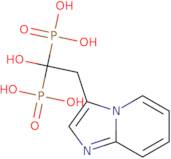Minodronic acid
CAS: 180064-38-4
Ref. 3D-FHA06438
| 25mg | Discontinued | ||
| 50mg | Discontinued | ||
| 100mg | Discontinued | ||
| 250mg | Discontinued | ||
| 500mg | Discontinued |
Product Information
- (1-Hydroxy-2-(imidazo[1,2-a]pyridin-3-yl)ethane-1,1-diyl)diphosphonicacid
- 1-Hydroxy-2-(Imidazo[1,2-a]pyridin-3-yl)ethane-1,1-diphosphonic acid
- Bonoteo
- Bph 261
- Imidazo[1,2-a]pyridine, phosphonic acid deriv.
- Ono 5920
- P,P′-(1-Hydroxy-2-imidazo[1,2-a]pyridin-3-ylethylidene)bis[phosphonic acid]
- Phosphonic Acid, (1-Hydroxy-2-Imidazo(1,2-A)Pyridin-3-Ylethylidene)Bis-
- Phosphonic acid, P,P′-(1-hydroxy-2-imidazo[1,2-a]pyridin-3-ylethylidene)bis-
- Recalbon
- See more synonyms
- Yh 529
- Ym 529
- [1-Hydroxy-2-(Imidazo[1,2-A]Pyridin-3-Yl)Ethane-1,1-Diyl]Bis(Phosphonic Acid)
- [1-Hydroxy-2-(imidazo[1,2-a]pyridin-3-yl)ethylidene]bisphosphonic acid
Minodronic acid is a bisphosphonate that acts as an inhibitor of osteoclasts. It is used to treat and prevent the recurrence of bone loss from various causes, such as cancer-induced bone metastasis or postmenopausal osteoporosis. Minodronic acid inhibits the production of cytokines, leading to decreased inflammation and improved cell survival. Minodronic acid also has antioxidative properties and is able to stimulate basic fibroblast growth in vitro. Minodronate was first isolated in 1967 by British scientists who were studying the effects of organic solvents on kidney cells. They found that minodronate was capable of preventing renal cell cancer in mice by inhibiting the growth of these cells.
Minodronate has been shown to be a potent inhibitor of DNA synthesis in bacterial cells, but it does not affect bacterial growth.





